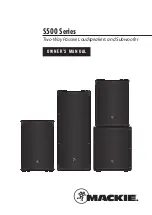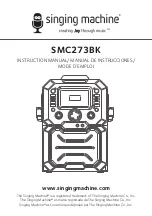
1. Power source stops
2. No weld current, fuse blowing in 13amp plug
3. No weld current
4. Feed motor not working, lamp is on
5. Wire does not feed, feed roller rotates
6. Wire feeds unevenly.
7. Unstable arc.
8. Porous weld
9. Electrode sticking in gas cup (nozzle)
10. Irregular weld head
11. Weld bead too narrow and raised
12. Weld bead too wide
13. Poor penetration
14. Excessive penetration
15. Fuse blowing
16. Coils of wire on reel overlap, or wire is
oxidised. Coils break or fall under wheel.
17. Wire runs through torch but there is no
welding current.
Overheating protection activated due to overload
Rectifier blown
Bad connection between clamp & workpiece
Break in earth lead
Break in torch lead
Fuse blown
Gear damaged or worn
Motor defective
Pressure roller improperly adjusted
Dirt, copper, dust, etc, have collection in torch liner
Gas cup (Nozzle) or tip defective. Faulty speed control
Deformed wire
Spot timer is ON.
Dirt, etc, in liner
Gas cup (Nozzle) or Tip defective
Gas cup (Nozzle) spattered
Feed roller groove clogged
Feed roller groove deformed
Pressure roller tension improper
Incorrect settings
Impurities in weld area
Worn or defective gas cup (nozzle)
No gas
Gas cup clogged
Draft blowing away shielding gas
Rusty or dirty joints
Torch too far from or at wrong angle to work
Gas leak
Dirty Workpiece
Worn or defective gas cup (nozzle)
Electrode deformed
Wire speed too slow
Torch incorrectly held
Wire weaving in weld pool
Weld current too high
Weld speed too low
Weld current too high
Weld speed too low
Arc too long
Weld current too high
Arc too long
Weld current too high
weld speed too slow
incorrect distance of torch to workpiece
Tension too great
Gas cup contact tip clogged
Tension to loose or tight. Coil damaged or wire twisted.
Defective contactor.
Worn contacts of contactor regulator.
Regulation switch problem
Faulty rectifier.
Fault on electronic circuit of contactor.
Work cable not connected correctly.
PROBLEM
POSSIBLE CAUSE
REMEDY
(Numbers refer to chapter and item heading)
6. TROUBLESHOOTING
Protection automatically resets when transformer has cooled (about 15 min).
Replace rectifier.
Clean or grind contact surface and weld area.
Repair or replace earth lead.
Repair or replace torch, lead.
Replace fuse 1.5 amp. (Chapter 5).
Replace gears. (Chapter 5).
Replace motor (Contact service agent).
Adjust tension.
Clean the liner from the machine forward. Use compressed air. If too much
dirt, replace the liner.
Replace gas cup (nozzle) and/or tip. (Chapter 5).
Check roller tension and adjust it if necessary (Chapter 3).
Clean the liner from the machine forward. Use compressed air.
Replace gas cup (nozzle) and/or tip. (Chapter 5).
Clean or replace gas cup (nozzle) (Chapter 5).
Clean feed roller. (Chapter 5).
Replace feed roller. (Chapter 5).
Adjust tension. (Chapter 3).
Check settings. (Chapter 4).
Clean and/or grind workpiece. (Chapter 4).
Replace gas cup (nozzle). (Chapter 5).
Open gas cylinder, regulate gas flow.
Clean or replace cup. (Chapter 5).
Screen off welding site or increase gas flow.
Clean or grind the workpiece (Chapter 4).
The distance from gas cup to workpiece should be 8-10mm
See chapter 4 for angle. Check contact tip and nozzle.
Check hoses, connections and torch assembly. (Chapter 5).
Press the gas cup into correct position.
Replace gas cup (nozzle). (Chapter 5).
Check roller tension. (Chapter 3).
See recommendations for wire speed.
Use correct torch angle. (Chapter 4).
Check roller tension and adjust as needed. (Chapter 3).
Increase power and wire speed.
Move torch slower and weave a little more.
Decrease power and wire speed.
Move torch faster and weave less.
Bring torch closer to workpiece.
Increase power and wire speed.
Bring torch closer to workpiece.
Decrease power and wire speed.
Move torch faster.
Torch distance should be 8-10mm.
Release tension. (Chapter 3).
Clean gas cup and contact tip. (Chapter 5).
Reset tension. Change wire reel.
Check coil ends, change coil if necessary.
Check, clean contacts, change if oxidation is present.
Check secondary voltage for each switch setting.
Disconnect rectifier from secondary, check each diode goes one way only.
If not change rectifier.
Change control module.
Connect work clamp directly to workpiece. Check wire is in good condition
and making good contact with clamp.
Sole UK Distributor
Sealey Group,
Bury St. Edmunds, Suffolk.
01284 757500
E-mail:
01284 703534
NOTE:
It is our policy to continually improve products and as such we reserve the right to alter data, specifications and component parts without prior notice.
IMPORTANT:
No liability is accepted for incorrect use of product.
WARRANTY:
Guarantee is 12 months from purchase date, proof of which will be required
for any claim.
INFORMATION:
Call us for a copy of our latest catalogue on 01284 757525 and leave your full name and address including your postcode.
Declaration of Conformity
We, the sole importer into the UK, declare that the product
s
listed below
are
in conformity with the following
EEC standards and directives.
The construction file
s
for th
ese
product
s are
held by the Manufacturer
and may be inspected by a national authority by contacting Jack Sealey
Ltd
For Jack Sealey Ltd. Sole importer into the UK of Sealey
as Power Welders
27th October 2000
Signed by Mark Sweetman
Models: POWERMIG2500, POWERMIG2750,
POWERMIG3500, POWERMIG4500.
Low Voltage Directive (S.I. 1994/3260) 73/23/EEC
EMC Directive (S.I. 1992/2372 & Amendments).
89/336/EEC
POWERMIG2500, 2750, 3500, 4500. - (0051) - (1) - 270100

























